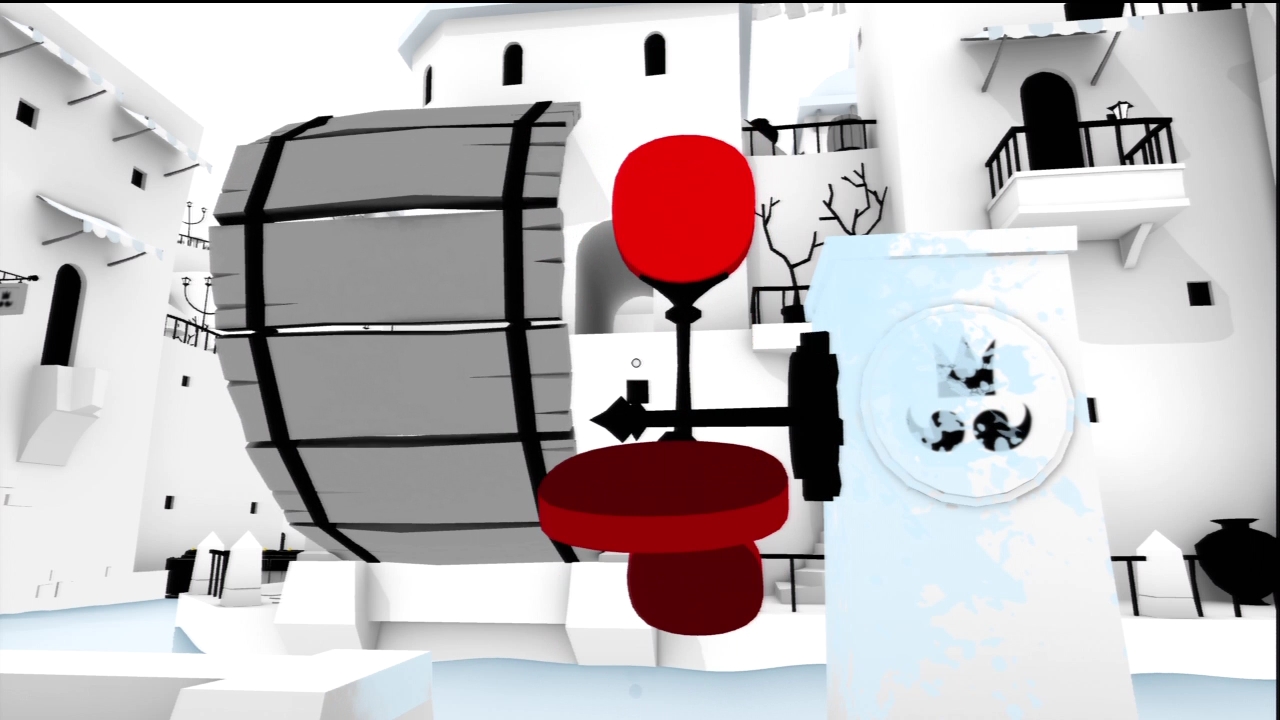A completely blank screen, save a tiny reticle, is what greets you when you first start The Unfinished Swan. You might stare at the screen equally blankly for a few seconds, anticipating the conclusion of a load that isn't happening. Instead, with no tutorial or instructions of any kind (unless you've looked at the controller options), you must grab your Sixaxis or PlayStation Move controller and experiment. You soon find you can shoot little balls of black paint with the press of the trigger, and the paint--if you spread it liberally enough--eventually reveals the contours of the first level, which you navigate from a first-person perspective.
As you make your way through the game's levels, the story is revealed to you in the form of an elaborate fairy tale about a king who craves control. You play as Monroe, a small boy who was placed in an orphanage after his mother's death. Allowed to keep one of his mother's many paintings as a keepsake, Monroe chooses her unfinished painting of a swan, and it's possible that the gameworld takes place inside this magical painting--or perhaps in a dream. The swan itself acts as your guide throughout the game, its footsteps leading you along the right path, and its occasional trumpets drawing your attention to important events.
It's not all black paint and feeling your way through the maps, however. As you get further in, The Unfinished Swan expands into a more traditional first-person puzzle game. On one level, you use aqua paint blotches to "water" a never-ending vine plant to make it grow over walls so you can climb them, for example. On another, the dark-on-light motif is reversed as you try to feel your way through a nighttime forest. While these changes are great atmospherically, they also emphasize the extreme simplicity of The Unfinished Swan's gameplay. You just walk around, point, and shoot. That's it. Sometimes the paint does more than reveal the level's structure, but it never does more than one thing (such as make vines grow).

Thus, the puzzles in The Unfinished Swan feel more like a shallow afterthought than a way of enhancing your emotional connection to the proceedings--you just keep pressing the "shoot paint" button until something happens. Additionally, the game gives you plenty of clues in the form of assistance from the titular swan or from other paintings and maps you come across, which further inhibits your intellectual engagement. Outside the core activities, you fire paint pellets at balloons to collect them. Collecting these allows you to unlock new abilities to use in the game, which might make it simpler and quicker to throw paint around, lead you more easily to the hidden balloons, or allow you to access chapters directly from the main menu. But none of these new abilities meaningfully deepen or expand the core mechanics, nor do they add layers to the gameworld.
That gameworld is extremely sparse and minimalist. It's a striking aesthetic, and it grows somewhat more colorful as you proceed, but it tends to add to the monochrome nature of the game--in every sense of the word. There’s a fine line between simple and simplistic, and The Unfinished Swan ends up on the wrong side of it all too often. Your interaction with the game rarely evolves, and ultimately is secondary to its value as a work of art and entertainment. The storyline and sense of wonder, then, must bolster the primary offering--and they do, to a certain extent. But to experience this world to its fullest, you must discover (and shoot) semi-hidden story panels throughout the game world, which is a frustrating limitation given how the game relies primarily on elements other than gameplay to draw you in.
Nevertheless, there's much to admire about The Unfinished Swan, even if it feels, well, unfinished. The basic idea behind its paint-blotching mechanic is innovative, and you can imagine a fuller realization of it in a game yet to come. And though the storyline is childlike, it isn't puerile, and the denouement offers more emotional heft than you might be prepared for. More than anything, The Unfinished Swan feels promising, but promising gets you only so far in a work of art, and the truth is, this one just isn't ready for the museum.
